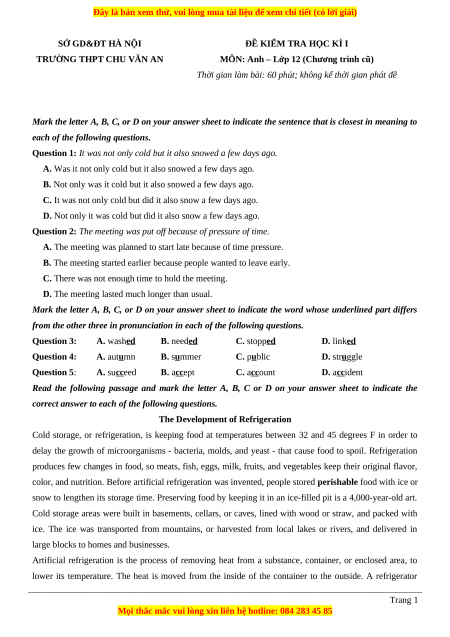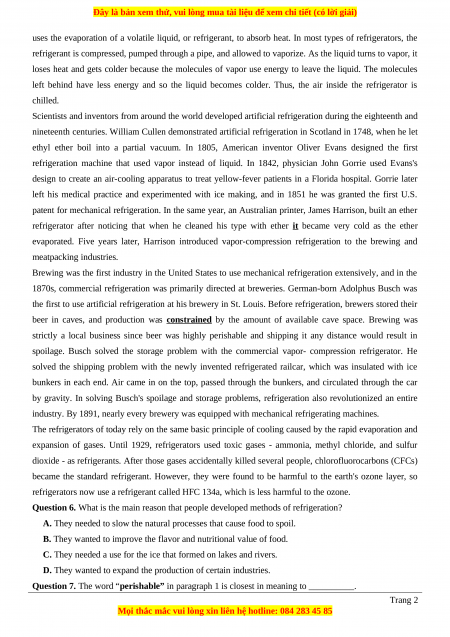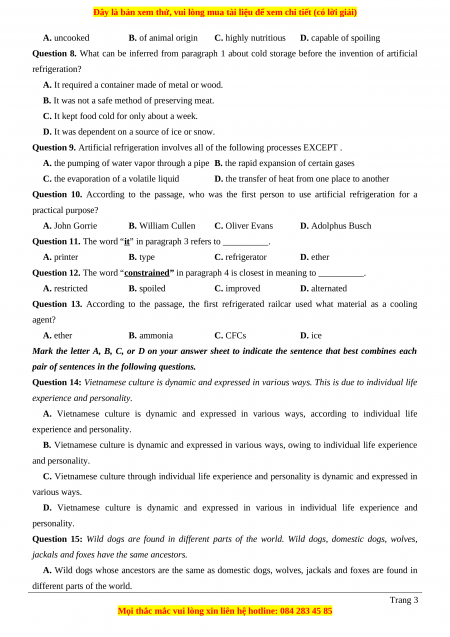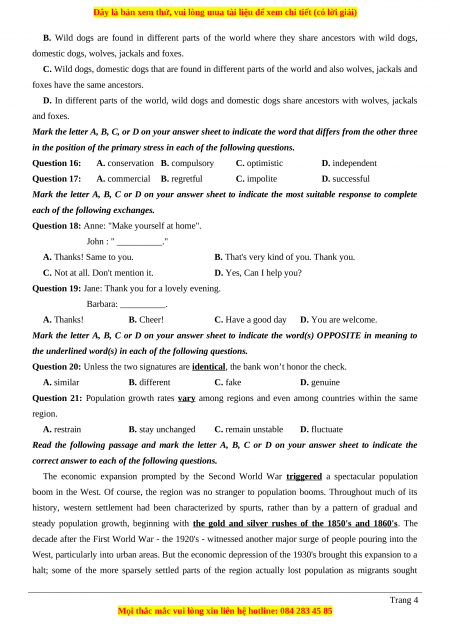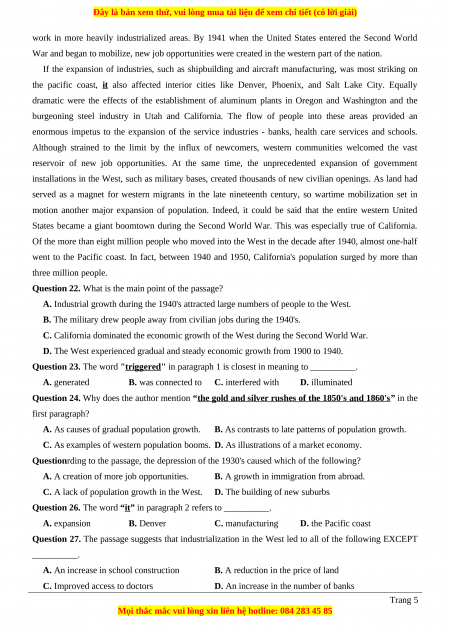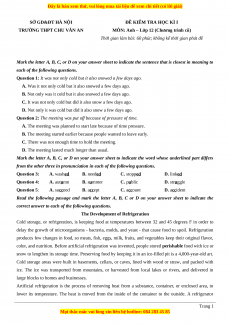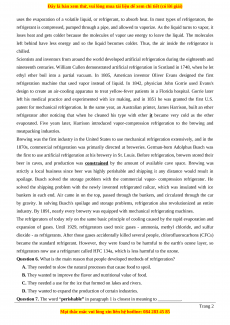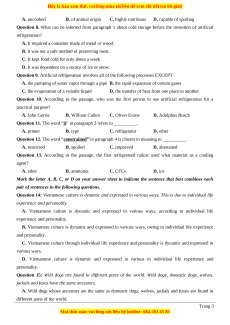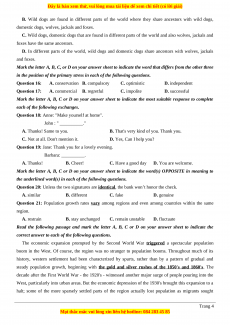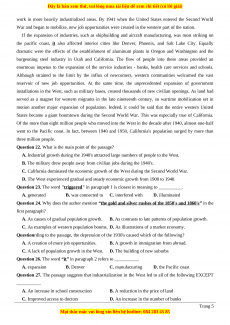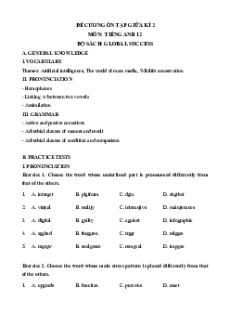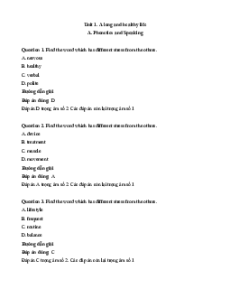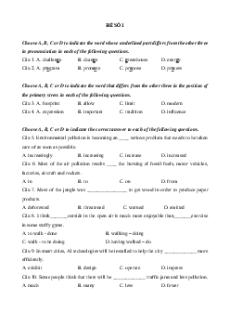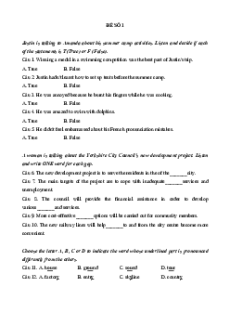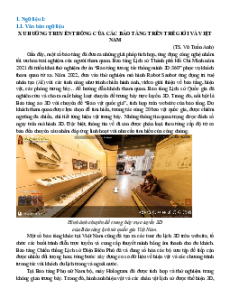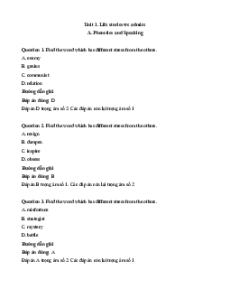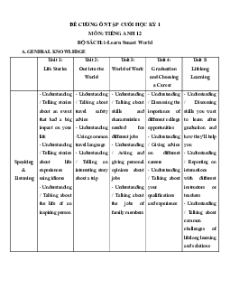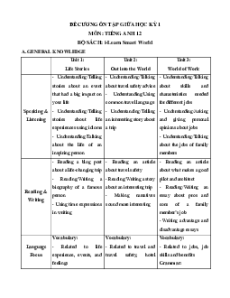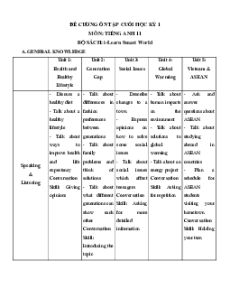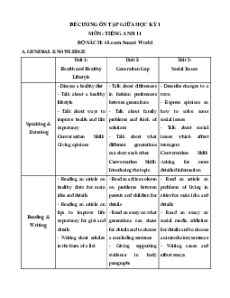SỞ GD&ĐT HÀ NỘI
ĐỀ KIỂM TRA HỌC KÌ I
TRƯỜNG THPT CHU VĂN AN
MÔN: Anh – Lớp 12 (Chương trình cũ)
Thời gian làm bài: 60 phút; không kể thời gian phát đề
Mark the letter A, B, C, or D on your answer sheet to indicate the sentence that is closest in meaning to
each of the following questions.
Question 1: It was not only cold but it also snowed a few days ago.
A. Was it not only cold but it also snowed a few days ago.
B. Not only was it cold but it also snowed a few days ago.
C. It was not only cold but did it also snow a few days ago.
D. Not only it was cold but did it also snow a few days ago.
Question 2: The meeting was put off because of pressure of time.
A. The meeting was planned to start late because of time pressure.
B. The meeting started earlier because people wanted to leave early.
C. There was not enough time to hold the meeting.
D. The meeting lasted much longer than usual.
Mark the letter A, B, C, or D on your answer sheet to indicate the word whose underlined part differs
from the other three in pronunciation in each of the following questions. Question 3: A. washed B. needed C. stopped D. linked Question 4: A. autumn B. summer C. public D. struggle Question 5: A. succeed B. accept C. account D. accident
Read the following passage and mark the letter A, B, C or D on your answer sheet to indicate the
correct answer to each of the following questions.
The Development of Refrigeration
Cold storage, or refrigeration, is keeping food at temperatures between 32 and 45 degrees F in order to
delay the growth of microorganisms - bacteria, molds, and yeast - that cause food to spoil. Refrigeration
produces few changes in food, so meats, fish, eggs, milk, fruits, and vegetables keep their original flavor,
color, and nutrition. Before artificial refrigeration was invented, people stored perishable food with ice or
snow to lengthen its storage time. Preserving food by keeping it in an ice-filled pit is a 4,000-year-old art.
Cold storage areas were built in basements, cellars, or caves, lined with wood or straw, and packed with
ice. The ice was transported from mountains, or harvested from local lakes or rivers, and delivered in
large blocks to homes and businesses.
Artificial refrigeration is the process of removing heat from a substance, container, or enclosed area, to
lower its temperature. The heat is moved from the inside of the container to the outside. A refrigerator Trang 1
uses the evaporation of a volatile liquid, or refrigerant, to absorb heat. In most types of refrigerators, the
refrigerant is compressed, pumped through a pipe, and allowed to vaporize. As the liquid turns to vapor, it
loses heat and gets colder because the molecules of vapor use energy to leave the liquid. The molecules
left behind have less energy and so the liquid becomes colder. Thus, the air inside the refrigerator is chilled.
Scientists and inventors from around the world developed artificial refrigeration during the eighteenth and
nineteenth centuries. William Cullen demonstrated artificial refrigeration in Scotland in 1748, when he let
ethyl ether boil into a partial vacuum. In 1805, American inventor Oliver Evans designed the first
refrigeration machine that used vapor instead of liquid. In 1842, physician John Gorrie used Evans's
design to create an air-cooling apparatus to treat yellow-fever patients in a Florida hospital. Gorrie later
left his medical practice and experimented with ice making, and in 1851 he was granted the first U.S.
patent for mechanical refrigeration. In the same year, an Australian printer, James Harrison, built an ether
refrigerator after noticing that when he cleaned his type with ether it became very cold as the ether
evaporated. Five years later, Harrison introduced vapor-compression refrigeration to the brewing and meatpacking industries.
Brewing was the first industry in the United States to use mechanical refrigeration extensively, and in the
1870s, commercial refrigeration was primarily directed at breweries. German-born Adolphus Busch was
the first to use artificial refrigeration at his brewery in St. Louis. Before refrigeration, brewers stored their
beer in caves, and production was constrained by the amount of available cave space. Brewing was
strictly a local business since beer was highly perishable and shipping it any distance would result in
spoilage. Busch solved the storage problem with the commercial vapor- compression refrigerator. He
solved the shipping problem with the newly invented refrigerated railcar, which was insulated with ice
bunkers in each end. Air came in on the top, passed through the bunkers, and circulated through the car
by gravity. In solving Busch's spoilage and storage problems, refrigeration also revolutionized an entire
industry. By 1891, nearly every brewery was equipped with mechanical refrigerating machines.
The refrigerators of today rely on the same basic principle of cooling caused by the rapid evaporation and
expansion of gases. Until 1929, refrigerators used toxic gases - ammonia, methyl chloride, and sulfur
dioxide - as refrigerants. After those gases accidentally killed several people, chlorofluorocarbons (CFCs)
became the standard refrigerant. However, they were found to be harmful to the earth's ozone layer, so
refrigerators now use a refrigerant called HFC 134a, which is less harmful to the ozone.
Question 6. What is the main reason that people developed methods of refrigeration?
A. They needed to slow the natural processes that cause food to spoil.
B. They wanted to improve the flavor and nutritional value of food.
C. They needed a use for the ice that formed on lakes and rivers.
D. They wanted to expand the production of certain industries.
Question 7. The word “perishable” in paragraph 1 is closest in meaning to __________. Trang 2
A. uncooked B. of animal origin C. highly nutritious D. capable of spoiling
Question 8. What can be inferred from paragraph 1 about cold storage before the invention of artificial refrigeration?
A. It required a container made of metal or wood.
B. It was not a safe method of preserving meat.
C. It kept food cold for only about a week.
D. It was dependent on a source of ice or snow.
Question 9. Artificial refrigeration involves all of the following processes EXCEPT .
A. the pumping of water vapor through a pipe B. the rapid expansion of certain gases
C. the evaporation of a volatile liquid
D. the transfer of heat from one place to another
Question 10. According to the passage, who was the first person to use artificial refrigeration for a practical purpose? A. John Gorrie B. William Cullen C. Oliver Evans D. Adolphus Busch
Question 11. The word “it” in paragraph 3 refers to __________. A. printer B. type C. refrigerator D. ether
Question 12. The word “constrained” in paragraph 4 is closest in meaning to __________. A. restricted B. spoiled C. improved D. alternated
Question 13. According to the passage, the first refrigerated railcar used what material as a cooling agent? A. ether B. ammonia C. CFCs D. ice
Mark the letter A, B, C, or D on your answer sheet to indicate the sentence that best combines each
pair of sentences in the following questions.
Question 14: Vietnamese culture is dynamic and expressed in various ways. This is due to individual life
experience and personality.
A. Vietnamese culture is dynamic and expressed in various ways, according to individual life experience and personality.
B. Vietnamese culture is dynamic and expressed in various ways, owing to individual life experience and personality.
C. Vietnamese culture through individual life experience and personality is dynamic and expressed in various ways.
D. Vietnamese culture is dynamic and expressed in various in individual life experience and personality.
Question 15: Wild dogs are found in different parts of the world. Wild dogs, domestic dogs, wolves,
jackals and foxes have the same ancestors.
A. Wild dogs whose ancestors are the same as domestic dogs, wolves, jackals and foxes are found in different parts of the world. Trang 3
B. Wild dogs are found in different parts of the world where they share ancestors with wild dogs,
domestic dogs, wolves, jackals and foxes.
C. Wild dogs, domestic dogs that are found in different parts of the world and also wolves, jackals and
foxes have the same ancestors.
D. In different parts of the world, wild dogs and domestic dogs share ancestors with wolves, jackals and foxes.
Mark the letter A, B, C, or D on your answer sheet to indicate the word that differs from the other three
in the position of the primary stress in each of the following questions. Question 16:
A. conservation B. compulsory C. optimistic D. independent Question 17:
A. commercial B. regretful C. impolite D. successful
Mark the letter A, B, C or D on your answer sheet to indicate the most suitable response to complete
each of the following exchanges.
Question 18: Anne: "Make yourself at home". John : " __________."
A. Thanks! Same to you.
B. That's very kind of you. Thank you.
C. Not at all. Don't mention it.
D. Yes, Can I help you?
Question 19: Jane: Thank you for a lovely evening. Barbara: __________. A. Thanks! B. Cheer! C. Have a good day D. You are welcome.
Mark the letter A, B, C or D on your answer sheet to indicate the word(s) OPPOSITE in meaning to
the underlined word(s) in each of the following questions.
Question 20: Unless the two signatures are identical, the bank won’t honor the check. A. similar B. different C. fake D. genuine
Question 21: Population growth rates vary among regions and even among countries within the same region. A. restrain B. stay unchanged C. remain unstable D. fluctuate
Read the following passage and mark the letter A, B, C or D on your answer sheet to indicate the
correct answer to each of the following questions.
The economic expansion prompted by the Second World War triggered a spectacular population
boom in the West. Of course, the region was no stranger to population booms. Throughout much of its
history, western settlement had been characterized by spurts, rather than by a pattern of gradual and
steady population growth, beginning with the gold and silver rushes of the 1850's and 1860's. The
decade after the First World War - the 1920's - witnessed another major surge of people pouring into the
West, particularly into urban areas. But the economic depression of the 1930's brought this expansion to a
halt; some of the more sparsely settled parts of the region actually lost population as migrants sought Trang 4
Đề thi học kì 1 Tiếng anh 12 năm 2022 - 2023 (Đề 16)
CÁCH MUA:
- B1: Gửi phí vào TK:
1133836868- CT TNHH DAU TU VA DV GD VIETJACK - Ngân hàng MB (QR) - B2: Nhắn tin tới Zalo VietJack Official ( nhấn vào đây ) để xác nhận thanh toán và tải tài liệu - giáo án
Liên hệ ngay Hotline hỗ trợ: 084 283 45 85
Đề thi được cập nhật liên tục trong gói này từ nay đến hết tháng 6/2023. Chúng tôi đảm bảo đủ số lượng đề đã cam kết hoặc có thể nhiều hơn, tất cả có BẢN WORD, LỜI GIẢI CHI TIẾT và tải về dễ dàng.
Để tải tài liệu gốc về máy bạn click vào nút Tải Xuống ở trên!
Thuộc bộ (mua theo bộ để tiết kiệm hơn):
-
Tailieugiaovien.com.vn giới thiệu bộ 21 đề thi học kì 1 môn Tiếng Anh lớp 12 mới nhất năm 2022 - 2023 nhằm giúp Giáo viên có thêm tài liệu tham khảo ra đề thi Tiếng anh lớp 12.
-
File word có lời giải chi tiết 100%.
-
Mua trọn bộ sẽ tiết kiệm hơn tải lẻ 50%.
Đánh giá
4.6 / 5(439 )Trọng Bình
Giúp ích cho tôi rất nhiều
Duy Trần
Rất thích tài liệu bên VJ soạn (bám sát chương trình dạy)
TÀI LIỆU BỘ BÁN CHẠY MÔN Tiếng Anh
Xem thêmTÀI LIỆU BỘ BÁN CHẠY Lớp 12
Xem thêmTài liệu bộ mới nhất





